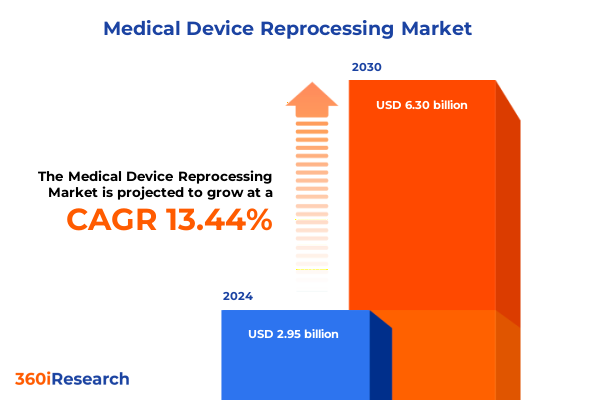The Medical Device Reprocessing Market size was estimated at USD 2.95 billion in 2024 and expected to reach USD 3.37 billion in 2025, at a CAGR 13.44% to reach USD 6.30 billion by 2030.

Introduction to the Medical Device Reprocessing Market
The evolution of the medical device reprocessing market is driven by an imperative need to balance cost efficiency with uncompromised patient safety. In today’s healthcare environment, strict regulatory measures, escalating equipment costs, and heightened expectations for sustainability have catalyzed a rigorous exploration of reprocessing practices. The market is recognizing that reprocessing not only extends the life cycle of expensive equipment but also plays a critical role in reducing waste and promoting efficient resource utilization. In light of this, numerous healthcare organizations are investing in advanced cleaning, disinfection, and sterilization processes that underscore a commitment to both patient care and environmental stewardship.
Technological advancements, along with stringent global guidelines, have redefined the protocols for device reprocessing. This introduction explores how integrated systems and innovative materials converge to deliver optimal sterilization and reuse strategies. A growing emphasis is being placed on innovation, compliance, and risk mitigation, as decision-makers seek to balance cost responsibilities with quality outcomes. Through rigorous market analysis and comprehensive trend evaluation, the overarching goal is to provide a clear understanding of market dynamics that affect operational efficiency and clinical outcomes within the complex landscape of medical device reprocessing.
Transformative Shifts in the Landscape
Recent years have witnessed transformative shifts in the medical device reprocessing landscape, with the rapid emergence of cutting-edge technologies as a major driver of change. Advanced automation and digital integration are reshaping practices, allowing healthcare providers to optimize cleaning and sterilization processes with unprecedented precision and efficiency. The development and implementation of state-of-the-art imaging, robotics, and real-time data analytics present a paradigm shift from traditional methods to more integrated, data-centric approaches.
Furthermore, evolving regulatory frameworks have mandated higher standards of operational excellence and safety, compelling industry stakeholders to continuously adapt and innovate. Enhanced process automation in cleaning, disinfection, and sterilization has not only streamlined operations but also significantly reduced human error. This conscientious shift towards more efficient practices is paralleled by a renewed interest in leveraging new material technologies and environmentally sustainable practices.
The confluence of these disruptive elements—technological advancements, stringent regulatory oversight, and a more dynamic approach to material and process innovation—has redefined the competitive landscape. Healthcare facilities are now able to better integrate predictive analytics and automation into existing workflows, effectively reducing turnaround times while ensuring uncompromised safety standards. As a result, stakeholders are poised to harness these changes as strategic opportunities that lead to improved patient outcomes and long-term cost savings.
Key Segmentation Insights
A detailed review of the medical device reprocessing market reveals multifaceted segmentation insights that drive strategic decision-making. Under the product type segmentation, the market is evaluated across macroeconomic devices, monitoring devices, and surgical instruments. Macroeconomic devices are analyzed by further breaking them down into critical categories such as cardiology equipment, gastroenterology devices, and orthopedic instruments. Likewise, monitoring devices are examined through the lens of anesthesia monitoring, fetal monitoring, and patient monitoring technologies. Surgical instruments receive similar detailed attention, with further segmentation into general and specialized instruments that are optimized for various procedural needs.
Further segmentation based on material type illustrates the importance of selecting optimal resources in device manufacturing. The analysis distinguishes components crafted from ceramics, metals, and plastics. Ceramics are appraised by differentiating between bioactive and bioinert varieties, whereas metals are categorized into aluminum, stainless steel, and titanium. Plastics are similarly scrutinized with particular focus on polycarbonate, polyethylene, and polypropylene. Meanwhile, process-based segmentation lays out a framework for understanding the cleaning, disinfection, and sterilization procedures that are pivotal in ensuring device safety. Within this, automated washing, disinfection cleaning, and ultrasonic cleaning represent the backbone of the cleaning process, while disinfection methodologies split into chemical and thermal approaches. When it comes to sterilization, advanced techniques such as ethylene oxide, plasma, and steam sterilization are differentiated by their operational efficiencies.
Additionally, the segmentation refined by end-user highlights the healthcare delivery aspects across ambulatory surgical centers, clinics, and hospitals, with each category revealing nuances such as multi-specialty and single-specialty centers, as well as distinctions between general and specialty clinics and the dichotomy between private and public hospitals. The integration of technological advances such as artificial intelligence and machine learning, cloud computing, and the Internet of Things further refines segmentation by emphasizing automation in operations, predictive analytics, cloud-based application hosting, cloud-oriented data management, and remote monitoring. Lastly, application-based segmentation divides the market into diagnostics instrument reprocessing, respiratory equipment reprocessing, and surgical instrument reprocessing, where the nuances include imaging and laboratory devices in diagnostics, ventilators in respiratory equipment, and distinctions within surgical reprocessing tailored for cardiovascular or general surgery. All these insights underscore the importance of granular segmentation as it guides manufacturers and healthcare providers in aligning their strategies with emerging trends.
This research report categorizes the Medical Device Reprocessing market to analyze trends and forecast revenues across various market segments:
- Product Type
- Material Type
- Process
- End-User
- Technology
- Application
Key Regional Insights
Analyzing the market across various geographic regions reveals unique trends that define regional dynamics. In the Americas, the market benefits from robust healthcare infrastructures and aggressive adoption of advanced reprocessing technologies, owing to continuously evolving regulatory standards and high patient safety benchmarks. This region showcases rapid innovation and a strong inclination toward process automation.
In the Europe, Middle East & Africa region, market dynamics are influenced by both established market practices and emerging economies. Here, regulatory bodies stress adherence to high safety standards while facilitating innovation through strategic public-private partnerships. Increased investments in state-of-the-art reprocessing and sterilization technologies have bolstered demand across both mature and developing economies.
The Asia-Pacific region is characterized by rapid economic growth and expanding healthcare accessibility. Technological advancements and a focus on cost efficiency have driven this region to adopt cutting-edge reprocessing techniques. The combination of rising disposable incomes, enhanced healthcare protocols, and investment in smart technologies positions the Asia-Pacific market as a critical hub for future industry developments. Through an integrated analysis, these regional insights offer valuable guidance to stakeholders seeking to tailor their strategies to the specific needs and regulatory frameworks operating in each region.
This research report examines key regions shaping Medical Device Reprocessing market trends, highlighting factors influencing growth and industry developments:
- Americas
- Asia-Pacific
- Europe, Middle East & Africa
Key Companies Insights
The competitive landscape of the medical device reprocessing market is marked by the active participation of prominent companies that have significantly influenced technological and operational standards. Leading the charge are multinational corporations such as 3M Company and Advanced Sterilization Products, which have consistently delivered innovative solutions that advance cleaning and sterilization processes. Alongside these dominant players are Advanced Health Solutions, Belimed AG, and Cardinal Health, Inc., each contributing with specialized expertise in medical technology and regulated process implementation.
Other influential entities include Ecolab USA Inc., Fujifilm Holdings Corporation, and GE Healthcare Technologies Inc. that maintain robust portfolios by leveraging state-of-the-art research and development. Companies such as Getinge AB, Innovative Health LLC, Johnson & Johnson Services, Inc., and Karl Storz SE & Co. KG further expand the market landscape by integrating high-end technological innovations and comprehensive reprocessing solutions. Additional market influencers—Medifix Solutions Pty Ltd., Medline Industries, Inc., NEScientific, Inc., and Olympus Corporation—continue to set benchmarks in operational efficiency and quality standards.
Pioneers in the industry such as Pioneer Medical Devices AG, ReNu Medical, Inc., Richard Wolf GmbH, and Ruhof Corporation have also played crucial roles by consistently refining their products to meet strict compliance guidelines while optimizing operational workflows. Complementing these leaders, Smith & Nephew PLC, Sotera Health Company, SteriPro Canada, Inc., Steris PLC, Stryker Corporation, SureTek Medical Inc., Teleflex Incorporated, UVC Solutions d.o.o., Vanguard AG, and Zimmer Biomet Holdings, Inc. underline the market’s diverse and competitive nature. These key players collectively exert influence not only through technological innovations and stringent compliance practices but also by driving strategic market partnerships, ultimately enhancing the overall value chain in the device reprocessing sector.
This report provides an overview of key companies, their market share and presence, and the strategies driving competition in the Medical Device Reprocessing market:
- 3M Company
- Advanced Sterilization Products
- Avante Health Solutions
- Belimed AG
- Cardinal Health, Inc.
- Ecolab USA Inc.
- Fujifilm Holdings Corporation
- GE Healthcare Technologies Inc.
- Getinge AB
- Innovative Health LLC
- Johnson & Johnson Services, Inc.
- Karl Storz SE & Co. KG
- Medifix Solutions Pty Ltd.
- Medline Industries, Inc.
- NEScientific, Inc.
- Olympus Corporation
- Pioneer Medical Devices AG
- ReNu Medical, Inc.
- Richard Wolf GmbH
- Ruhof Corporation
- Smith & Nephew PLC
- Sotera Health Company
- SteriPro Canada, Inc.
- Steris PLC
- Stryker Corporation
- SureTek Medical Inc.
- Teleflex Incorporated
- UVC Solutions d.o.o.
- Vanguard AG
- Zimmer Biomet Holdings, Inc.
Actionable Recommendations for Industry Leaders
Industry leaders should leverage emerging technological innovations by integrating automation and predictive analytics into reprocessing workflows. It is essential to invest in state-of-the-art cleaning, disinfection, and sterilization methodologies that reduce turnaround times while ensuring compliance with evolving regulatory standards.
Strategic collaborations with research institutions and technology innovators can further enhance process optimization and material selection. Leaders must also focus on sustainable practices and continuous training of personnel to keep pace with disruptive changes. Understanding granular segmentation and regional dynamics is key to tailoring effective market strategies that drive cost-efficiency and patient safety.
Explore AI-driven insights for the Medical Device Reprocessing market with ResearchAI on our online platform, providing deeper, data-backed market analysis.
Ask ResearchAI anything
World's First Innovative Al for Market Research
Conclusion
In conclusion, the landscape of medical device reprocessing is undergoing significant transformation, driven by technological advancements, strict regulatory mandates, and evolving market dynamics. A granular understanding of segmentation, regional trends, and the strategies adopted by key companies has exposed invaluable insights into the competitive milieu and operational imperatives of the industry.
The integration of innovative technologies, enhanced process improvements, and strategic partnerships will continue to shape the future of reprocessing within the healthcare domain. It is clear that a well-aligned approach—combining efficiency, quality, and safety—will serve as the cornerstone for sustained growth and improved patient outcomes in a rapidly evolving market.
This section provides a structured overview of the report, outlining key chapters and topics covered for easy reference in our Medical Device Reprocessing market comprehensive research report.
- Preface
- Research Methodology
- Executive Summary
- Market Overview
- Market Insights
- Medical Device Reprocessing Market, by Product Type
- Medical Device Reprocessing Market, by Material Type
- Medical Device Reprocessing Market, by Process
- Medical Device Reprocessing Market, by End-User
- Medical Device Reprocessing Market, by Technology
- Medical Device Reprocessing Market, by Application
- Americas Medical Device Reprocessing Market
- Asia-Pacific Medical Device Reprocessing Market
- Europe, Middle East & Africa Medical Device Reprocessing Market
- Competitive Landscape
- List of Figures [Total: 29]
- List of Tables [Total: 1078 ]
Call-To-Action
For those ready to dive deeper into the intricacies of the market, comprehensive insights are available in the market research report. Connect with Ketan Rohom, Associate Director, Sales & Marketing, to obtain a detailed analysis and leverage the data needed to make strategic decisions. Seize this opportunity to equip your organization with the intelligence to navigate and excel in the dynamic landscape of medical device reprocessing.

- How big is the Medical Device Reprocessing Market?
- What is the Medical Device Reprocessing Market growth?
- When do I get the report?
- In what format does this report get delivered to me?
- How long has 360iResearch been around?
- What if I have a question about your reports?
- Can I share this report with my team?
- Can I use your research in my presentation?




